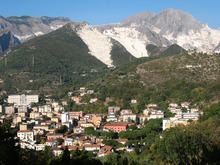Province / Metropolitan city Massa and Carrara (MS) Demonym(s) Carraresi | Elevation 100 m (300 ft) Postal code 54033 | |
 | ||
Frazioni Avenza, Bedizzano, Bergiola, Bonascola, Castelpoggio, Codena, Colonnata, Fontia, Fossola, Gragnana, Marina di Carrara, Miseglia, Nazzano, Noceto, Sorgnano, Torano Weather 11°C, Wind SW at 24 km/h, 81% Humidity Points of interest Carrara Cathedral, Palazzo Cucchiari, Monte Sagro, Palazzo Binelli, Piazza Alberica - Carrara Ms | ||
Carrara [karˈraːra] (Emilian: Carara) is a city and comune in the Province of Massa and Carrara (Tuscany, Italy), notable for the white or blue-grey marble quarried there. It is on the Carrione River, some 100 kilometres (62 mi) west-northwest of Florence.
Contents
- Map of 54033 Carrara Province of Massa and Carrara Italy
- History
- Title
- Main sights
- Economy and culture
- Derivation of name
- Twin towns
- Notable people
- References
Map of 54033 Carrara, Province of Massa and Carrara, Italy
Its motto is Fortitudo mea in rota (Latin: "My strength is in the wheel").
History
There were known settlements in the area as early as the 9th century BC, when the Apuan Ligures lived in the region. The current town originated from the borough built to house workers in the marble quarries created by the Romans after their conquest of Liguria in the early 2nd century BC. Carrara has been linked with the process of quarrying and carving marble since the Roman Age. Marble was exported from the nearby harbour of Luni at the mouth of river Magra.
In the early Middle Ages it was a Byzantine and then Lombard possession, and then, it was under bishops of Luni, turning itself into an city-state in the early 13th century; during the struggle between Guelphs and Ghibellines, Carrara usually belonged to the latter party. The Bishops acquired it again in 1230, their rule ending in 1313, when the city was given in succession to the Republics of Pisa, Lucca and Florence. Later it was acquired by Gian Galeazzo Visconti of Milan.
After the death of Filippo Maria Visconti of Milan in 1447, Carrara was fought over by Tommaso Campofregoso, lord of Sarzana, and again the Malaspina family, who moved here the seat of their signoria in the second half of the 15th century. Carrara and Massa formed the Duchy of Massa and Carrara from the 15th to the 19th century. Under the last Malaspina, Maria Teresa, who had married Ercole III d'Este, it became part of the Duchy of Modena.
After the short Napoleonic rule of Elisa Bonaparte, it was given back to Modena. During the unification of Italy age, Carrara was the seat of a popular revolt led by Domenico Cucchiari, and was a center of Giuseppe Mazzini's revolutionary activity.
At the end of the 19th century Carrara became the cradle of anarchism in Italy, in particular among the quarry workers. The quarry workers, including the stone carvers, had radical beliefs that set them apart from others. Ideas from outside the city began to influence the Carrarese. Anarchism and general radicalism became part of the heritage of the stone carvers. According to a New York Times article of 1894 many violent revolutionists who had been expelled from Belgium and Switzerland went to Carrara in 1885 and founded the first anarchist group in Italy. Carrara has remained a continuous 'hotbed' of anarchism in Italy, with several organizations located openly in the city. The Anarchist marble workers were also the driving force behind organising labour in the quarries and in the carving sheds. They were also the main protagonists of the Lunigiana revolt in January 1894.
In 1929, the municipalities of Carrara, Massa and Montignoso were merged in a single municipality, called Apuania. In 1945 the previous situation was restored.
Carrara is the birthplace of the International Federation of Anarchists (IFA), formed in 1968.
Title
As a titular Duke of Modena, the current holder of the title of "Prince of Carrara" would be Prince Lorenz of Belgium, Archduke of Austria-Este.
Main sights
Economy and culture
Carrara marble has been used since the time of Ancient Rome. The Pantheon and Trajan's Column in Rome are constructed of it, and many sculptures of the Renaissance were carved from it.
In addition to the marble quarries, the city has academies of sculpture and fine arts and a museum of statuary and antiquities, and a yearly marble technology fair. The local marble is exported around the world, and marble from elsewhere is also fashioned and sculpted commercially here.
Derivation of name
The word Carrara likely comes from the pre-Roman (Celtic or Ligurian) element kar (stone), through Latin carrariae meaning 'quarries'.
According to Saint Girolamo, the name Carrara derives from car meaning "wagons" and iara meaning "Moon", so is the “City of the Moon on the Wagons”.
Twin towns
Carrara is twinned with:
